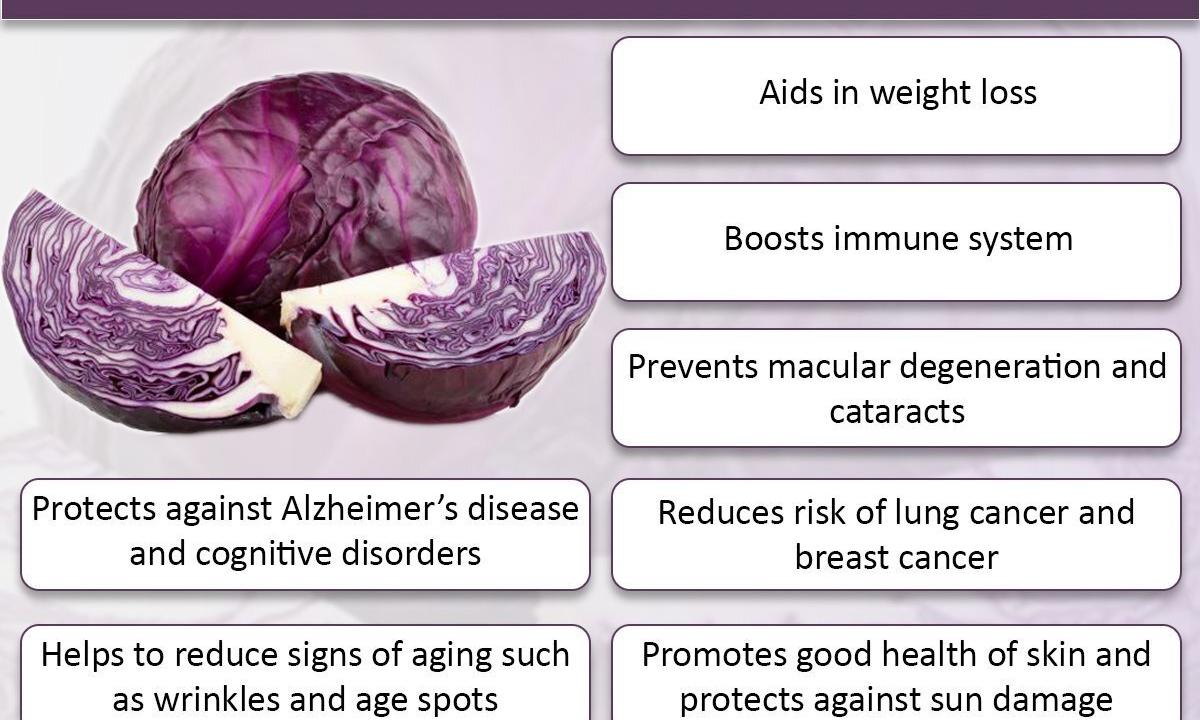The red cabbage is not so popular as the white version, but nevertheless is one of the most popular representatives of family Cabbage. Many do not try to enter red cabbage into the diet only owing to inertia of thinking, a habit. Perhaps, this material will force such people to experiment with this vegetable.
Caloric content and nutrition value
Caloric content of this vegetable is only 26 kcal on 100 grams of a product. Such quantity of cabbage contains 1.4 g of proteins, 0.16 g of fats and 7.4 g of carbohydrates. Food fibers as a part of 100 g of a product — 2.1 g, the rest — water with small impurity of ashes.
Whether you know? The red cabbage in the alkaline soil gets a blue or violet shade, and in sour soils — red. In the ancient time it was explained with sorcery.
Vitamin and mineral structure
This cabbage is vitamin-rich. It contains vitamins A, B1, B2, B4, B5, B6, B9, C, E, K, SS.
Such vegetables as carrots, spinach, green radish, corn, celery are also rich in various vitamins.
Content of the following vitamins is especially big:
- vitamin C — 57 mg on 100 grams of a product;
- RR vitamin — 0.42 mg;
- B6 vitamin — 0.21 mg;
- B5 vitamin — 0.15 mg;
- vitamin E — 0.11 mg.
Besides vitamins, such connections, important for normal functioning of a human body, as lycopene, lutein, zeaxanthin, a betaine are a part. Color of vegetable is caused by availability of substance of a flavonoid of the anthocyan which is antioxidant.
Besides, this product contains the following minerals in the greatest number:
- potassium — 243 mg on 100 grams of a product;
- calcium — 45 mg;
- phosphorus — 30 mg;
- sodium — 27 mg;
- magnesium — 16 mg.
Advantage for an organism
Thanks to existence in structure of a red cabbage of a set of vitamins, minerals and organic compounds, it possesses quite wide range of useful properties which are differently shown in various age groups and also at pregnant women and nursing mothers.
Whether you know? In antique times juice of a red cabbage was used as prophylactic from catarrhal diseases.
Adults
The bioactive agents which are contained in a red cabbage constrain development of the causative agent of tuberculosis, improve a condition of a blood system, reduce risk of developing of some diseases of a cardiovascular system.
Such products as bear fat, guelder-rose red, a girasol, flax seeds, squids, white tea are also capable to improve a blood system.
This vegetable possesses antioxidant action, improves immunity, reduces cholesterol level.
Pregnant women and the feeding women
During pregnancy this vegetable is very useful both to future mother, and to a fruit as a rich source of vitamins and minerals.
Pomegranate, feijoa, pumpkin, orange, white cabbage, cornel, cowberry, cloudberries is also useful to future mother.
It also improves elasticity and permeability of blood vessels that is especially important at pregnancy.
When breastfeeding the cabbage is entered into mother's diet very carefully, small portions, with tracking reaction of the child.
Important! Usually nursing mother is recommended to begin consumption of this vegetable not earlier than in ten days, and it is better even in three months after the child's birth. If after that at the baby gripes are observed, the use of cabbage should be stopped.
Children
Into the child's diet the red cabbage is recommended to enter not earlier than at one-year-old age, originally in the form of puree. This vegetable is especially useful to children that it strengthens immunity and normalizes work of digestive tract, but also, well influences mental activity of the child.
Learn about methods of strengthening of immunity to the child.
Elderly people
This vegetable is especially valuable to elderly people availability of anthocyan which is antioxidant. Besides, it promotes lowering of blood pressure that very opportunely for having a hypertension. The ability of vegetable to improve a condition of walls of vessels is also extremely useful to elderly people.
What can be prepared and what it is combined with
The fresh red cabbage is perfectly combined with fruit, berries or with other vegetables in salads. Similar salads perfectly approach meat as promote its assimilation by an organism.
It is also pickled, extinguished, fried, baked, made sour, boiled. Prepared in various ways, it is used as a separate dish, and in the form of a garnish to meat dishes. Besides, this vegetable is a component of various soups.
Important! This species of cabbage can give a violet shade to all dish. If it is desirable not to allow it, it is enough to add to a dish when cooking a little vinegar or lemon juice.
Whether it is possible to eat on a diet
Because of low caloric content this product is actively used in all diets for weight loss. On the other hand, experts recommend not to resort to the monodiet consisting of one this vegetable.
It is connected with extremely small amount of protein in it that can lead to deterioration in health. But as one of components of the balanced diet this cabbage is quite often entered into a diet.
Contraindications and harm
This vegetable is recommended to exclude from a diet at a duodenum ulcer at all. Besides, it cannot be used at the gastric diseases which are followed by the complicated digestion of food. With a certain care nursing mothers as it can cause gripes in the baby should use it.
In general it is possible to tell that the red cabbage not only has good tastes, but also is the real storeroom of useful substances. It can be in own way useful to people of various age. Nevertheless it is necessary to remember that at some diseases it is better to exclude it from a diet.

